Content
- Classification of diseases
- Herpes
- general characteristics
- Symptoms and Signs
- Causes
- Treatment methods
- Oral candidiasis
- general characteristics
- Symptoms and Signs
- Causes
- Treatment methods
- Tuberculosis
- general characteristics
- Symptoms and Signs
- Causes
- Treatment methods
- Lichen planus
- general characteristics
- Symptoms and Signs
- Causes
- Treatment methods
- Stomatitis
- general characteristics
- Symptoms and Signs
- Causes
- Treatment methods
- Caries
- general characteristics
- Symptoms and Signs
- Causes
- Treatment methods
- Video about diseases of the oral cavity
Diseases of the oral cavity are a specific category of diseasesaffecting the general condition of a person. Diseases affect not only the mucous membrane of the mouth, but also teeth and skin. Some diseases are quite "harmless" and do not require long-term therapy. Certain categories of diseases can progress, affecting other organs and systems of the body.
Classification of diseases
Diseases of the oral cavity are classified according to the causative agents of the disease:
| The nature of the disease | Examples of |
| Viral diseases | Herpes, papilloma, tuberculosis of the oral mucosa. |
| Fungal diseases | Oral candidiasis, lichen planus. |
| Infectious and inflammatory diseases | Pharyngitis, glossitis, gingivitis, stomatitis. |
| Other diseases | Dysbacteriosis of the oral cavity, caries. |
It is also possible to distribute diseases to the affected area. Diseases can affect the mucous membranes of the mouth, teeth, skin.
Herpes
Herpes belongs to the category of viral diseases. The most popular is the so-called “herpes simplex”.
general characteristics
Herpes is a viral disease that can be acute or chronic. The affected area can be different - the disease affects the mucous membranes and human skin. 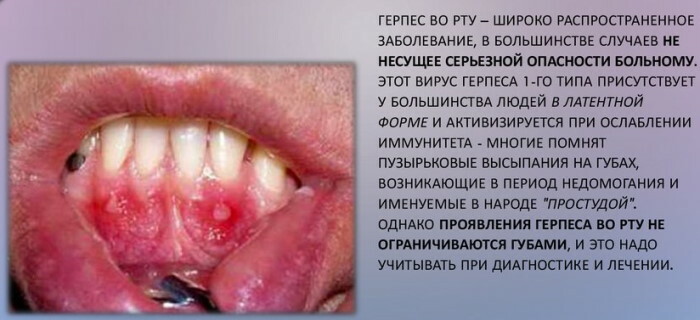 The source of infection is a person - herpes is transmitted in any phase, the most dangerous during an exacerbation.
The source of infection is a person - herpes is transmitted in any phase, the most dangerous during an exacerbation.
Symptoms and Signs
The carrier of the infection puts others at risk of infecting others. The virus is transmitted by airborne droplets, contact-household, sexually. Strong immunity against herpes does not exist - all people can be susceptible to the disease, but some are able to carry the disease in an asymptomatic form.
Herpes can be identified by the characteristic symptoms:
- the appearance of herpetic stomatitis (more often in children under 3 years of age);
- itchy blisters around the lips and on the nasolabial triangle;
- grouped vesicles with a clear liquid on the oral mucosa. After opening, ulcers are left;
- chills;
- increased fatigue, headache;
- lack of appetite;
- sleep disturbance.

Diseases of the oral cavity and teeth
The exact symptomatology depends on the type of herpes, the stage of development of the disease and other factors.
Causes
Herpes infection occurs as a result of person-to-person transmission of the virus.
The virus is activated by the following reasons:
- hypothermia or overheating;
- overwork, stressful situations;
- lack of sleep;
- avitaminosis;
- colds.
Recurrent herpes is observed in people who have suffered injuries associated with a violation of the integrity of the oral mucosa.
Treatment methods
Treating herpes on your own is dangerous to your health. If you experience herpes simplex, you need to see a specialist.
A qualified physician can suggest the following medications for treatment:
-
Acyclovir. The drug is used orally, after the diagnosis or manifestation of outbreaks of the disease. The dose and duration of treatment, as well as the form of release of the drug, depend on the indications.
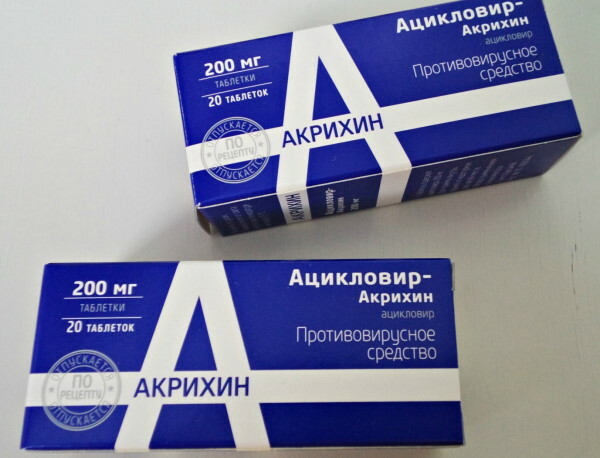
- Valtrex. For primary infection with herpes simplex, the recommended dose is 500 mg 2 times a day. The duration of treatment is 5 days. In case of recurrent herpes, it is recommended to use the drug, 500 mg once a day.
- Anaferon. It is used internally. The drug should not be taken simultaneously with food - keep the tablet until it is completely dissolved. The dosage and the number of receptions are determined by the specialist, depending on the type of disease.
Complicated forms of herpes cannot be cured at home. Patients are subject to hospitalization, followed by treatment in an inpatient setting.
Oral candidiasis
Diseases of the oral cavity, in most cases, belong to the category of fungal diseases. Thrush or oral candidiasis is one of such diseases, the probability of which spreading is about 50%.
general characteristics
Inactive fungi are located on the mucous membrane of the nose and throat, on the skin and the vagina. The fungus becomes more active when the vital functions of the body are reduced. It is especially dangerous for smokers.
Symptoms and Signs
Determining oral candidiasis is quite simple.
Its characteristic manifestations include:
- the appearance of a yellowish or grayish coating on the surface of the tongue;
- with candidal cheilitis, a white coating appears on the surface of the lips, as well as a red border around;
- the fungus can also develop on the tonsils, as well as the palate.
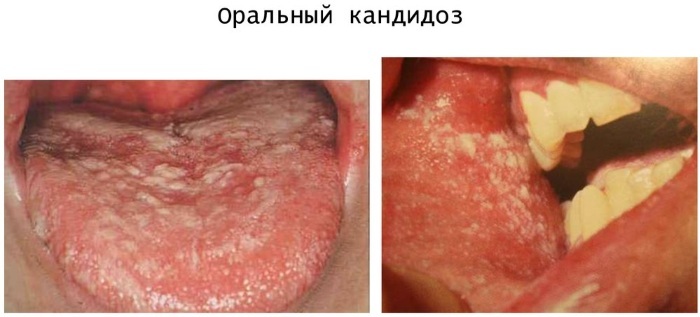 The peculiarity of candidiasis - after removing the formed plaque, the patient does not experience discomfort with swallowing, when talking.
The peculiarity of candidiasis - after removing the formed plaque, the patient does not experience discomfort with swallowing, when talking.
Causes
The cause of candidiasis is a fungus - a yeast-like microorganism.
Candida is always in the body, but the following conditions can provoke its active spread:
- lack of vitamins in the body;
- impaired metabolism, thyroid disease or hormonal disorders;
- chronic diseases of the gastrointestinal tract;
- human immunodeficiency virus in any form, as well as its consequences;
- fungal infections of the female genital organs;
- use of oral contraceptives;
- pregnancy;
- children's age (up to 10 years old);
- long-term antibiotic therapy;
- rickets;
- advanced age (from 60 years old).
It is also possible that candidiasis develops on mucous membranes, the integrity of which has been compromised due to physical, chemical or mechanical damage.
Treatment methods
Therapy for candidiasis includes medication and non-medication.
To eliminate the disease, the following drugs can be used:
- Nystatin. It is used for candidiasis of the lips - apply 2 times a day to the burned area. Can be used in conjunction with the internal use of the drug in stationary conditions.
-
Candide. Apply the drug to the affected areas 3-4 times a day. Apply 10-20 drops to the affected area. Do not use the drug at the same time as food. It is also not recommended to consume food and water before and after, about 1-2 hours.
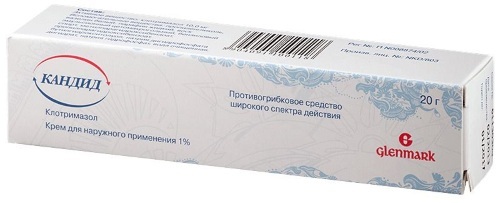
- Oralsept - the drug is available in the form of a metered-dose spray. It is recommended to use up to 8 doses per day for 4-6 times a day. The course of treatment depends on the severity of the disease - it can last up to 25 days.
The complete list of drugs depends on the stage of the disease. Point therapy is prescribed if candida has not affected other organs. Otherwise, systemic therapy is prescribed.
Other therapies:
- follow the rules of personal hygiene, including oral hygiene;
- observe the hygiene of dentures. Take them off at night;
- use antiseptics and antibacterial rinses.
These methods can be used as a prophylactic method to exclude relapse.
Tuberculosis
Diseases of the oral cavity can be chronic - a striking example of such diseases is oral tuberculosis. There are several main forms of tuberculosis, which differ in the modes of transmission, as well as the course of the disease.
general characteristics
The most popular form of oral tuberculosis is lupus tuberculosis. Its main and characteristic manifestation is symptomatology not only on the mucous membranes of the mouth, but also on the skin. Most often, the skin of the face is affected (about 75%).
Symptoms and Signs
Tuberculosis can be identified by the following manifestations:
- the appearance of mouth ulcers. Torn edges, hardened base and soreness are the hallmarks of tuberculous erosions;

- purulent lymphadenitis;
- painful formations that merge with each other;
- scarring of the oral cavity, characteristic of the 4th phase of tuberculosis.
The disease is developing rapidly. Certain types of tuberculosis progress with the formation of fistulas and ulcers over large areas.
Causes
There are few causes of tuberculosis in the oral cavity. The disease caused by Koch's sticks develops in the mouth due to spread through the lymphatic or circulatory systems. In some cases, transmission of the disease through sputum is possible, with the transfer of pulmonary tuberculosis.
Treatment methods
Tuberculosis treatment is carried out in stationary conditions. Initially - therapy of the main focus, and antiseptics are used as maintenance therapy and stop the spread of the disease.
After stopping the condition, it is necessary to maintain oral hygiene. An antiseptic can also be prescribed as a preventive measure.
Lichen planus
Lichen planus is a pathology of the mucous membrane, which is accompanied by the formation of erosions, papules, plaques. It is quite common. Among patients with lichen planus can be found from 50% of people suffering from the appearance of foci on the mucous membranes of the mouth.
general characteristics
Lichen planus often develops in women aged 30-50 years. Lesions are located on the gums, tongue, lips and back of the cheeks. At the same time, pathology cannot be transmitted.
Symptoms and Signs
Symptoms of lichen planus directly depend on the type of disease. Features of the course provoke various conditions, while a common manifestation is the formation of foci on the oral mucosa. 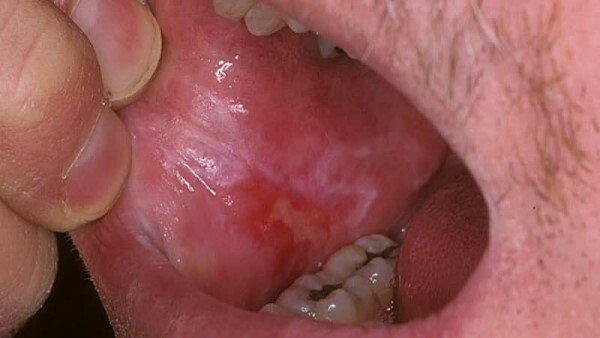 Some forms of the disease also cause a burning sensation, soreness when eating.
Some forms of the disease also cause a burning sensation, soreness when eating.
Causes
The causes of lichen are not fully established. It is believed that its occurrence was influenced by the immune response to the allergen.
The following provoking factors can be noted:
- chronic stressful conditions;
- diabetes;
- pathological conditions of the gastrointestinal tract;
- high blood pressure;
- mechanical damage to the oral mucosa.
Also, lichen planus appears in people using prostheses made of dissimilar metals.
Treatment methods
Medical therapy is determined by a specialist - it depends on the course, severity of the disease. The asymptomatic course does not require therapy with the use of drugs, while the formation of erosions and ulcers requires special treatment.
As a treatment for lichen planus, use:
-
Sibazon. 5-10 mg per day, divided into 2-4 doses. The drug is used for people with mental disorders. Therapy should not exceed 28 days.

- Fluconazole. Treatment with this drug is determined by a specialist. The dosage and duration of treatment depends on the severity of the disease and the form of the fungal infection.
- Tacrolimus. The drug is used for oral administration and intravenous administration. The daily dose must be divided into 2 doses, while not using the drug in conjunction with a meal.
Physical therapy is also often used to help the patient treat non-healing ulcers.
Stomatitis
Diseases of the oral cavity can cause inflammation that can spread to any area of the oral cavity. One of these diseases is stomatitis.
general characteristics
Stomatitis is a fairly common disease. Its "infectiousness" depends on the cause of its origin. Stomatitis against the background of an allergic reaction or poisoning with toxins is not contagious. If the disease manifests itself as a result of any infection, then it is necessary to carry out a set of preventive measures in order to protect loved ones from the onset of the disease.
Symptoms and Signs
Symptoms of stomatitis:
- the appearance of a slight swelling in the mouth. Swelling is accompanied by slight redness;
- an increase in the affected area, accompanied by a burning sensation;
- the formation of a white spot in the focus of the disease.
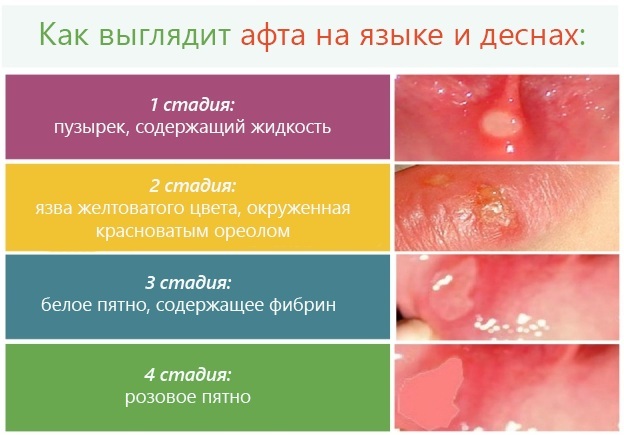
It is quite simple to determine stomatitis - you need to conduct a thorough visual examination.
Causes
There are quite a few reasons for the appearance of the disease. Depending on the factors, additional symptoms change that affect the quality of a person's life.
Factors causing pathology:
- mechanical damage to the oral mucosa from solid food or tooth fragments. With long non-healing wounds, a complication is possible, manifested by ulcers. This factor provokes stomatitis;
- acidification of saliva and lack of vitamins. High-carbohydrate foods that are consumed in large quantities on a regular basis increase the acidity of saliva;
- allergic reactions;
- the use of funds for the sanitation of the oral cavity. Some toothpastes are capable of creating an environment conducive to the development of stomatitis;
- violation of the microflora of the oral cavity;
- hormonal disbalance;
- genetic predisposition.
Also, stomatitis can manifest itself in conjunction with other viruses that are inactive in the human body.
Treatment methods
It is recommended to treat stomatitis under the supervision of a specialist. Certain forms of the disease can lead to atrophy of the tongue, therefore, if symptoms are found, it is necessary to consult a doctor.
The following drugs can be used:
-
Tavegil. Apply orally, 1 tab. 2 times a day. The maximum single dose cannot exceed more than 2 tablets. If necessary, the doctor can prescribe up to 6 tablets. per day
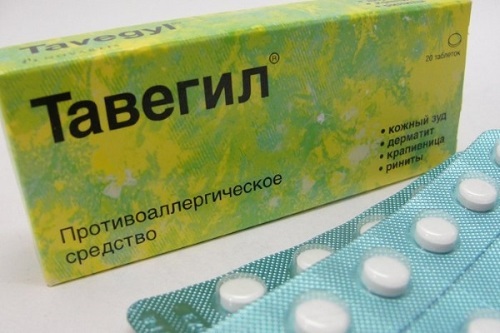
- Bonafton. Apply to the affected areas of the oral mucosa up to 6 times a day, in a thin layer. The course of treatment depends on the severity of the disease and can be up to 3 weeks of continuous use.
- Diflucan. Therapy using this drug is determined individually - depending on the indications of each patient. The duration of admission is also determined by the doctor.
Complete treatment depends on the form and cause of stomatitis.
Caries
A lot of different processes take place in the oral cavity, some of which can be called degenerative or destructive. One of these processes is dental caries, the spread of which reaches about 98% of people on all continents.
general characteristics
Dental caries refers to destructive processes in the bone, which leads to partial or complete destruction of the tooth. Caries can be of different depths and can lead to complete loss of a tooth.
Symptoms and Signs
The symptomatology of caries depends directly on the depth of the tooth damage.
Manifestations:
- damage to enamel - the appearance of a stain of a dirty shade on the surface of the tooth;
- pain syndrome;
- painful and acute reaction to cold, hot food.
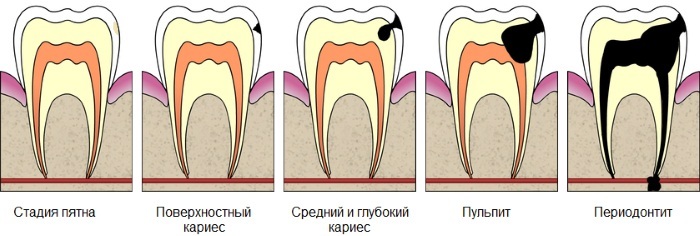
Caries affects individual teeth, but can occur on adjacent teeth, or on the entire row at the same time.
Causes
Causes of dental caries:
- diseases of the gastrointestinal tract;
- decreased immunity;
- plaque, poor oral hygiene.
Also, the formation of caries can be influenced by the environment, an unfavorable environment.
Treatment methods
Caries treatment involves the complete removal of the affected tissue. The procedure is performed by dentists after diagnostic procedures. In the future, you can provide preventive measures to prevent re-development.
Diseases of the oral cavity, in most cases, are directly associated with pathologies of other organs. Most of the diseases occurring in the oral cavity are the result of disruption of the gastrointestinal tract and the respiratory system.
Video about diseases of the oral cavity
Diseases of the oral cavity. Bleeding gums, tooth sensitivity:



